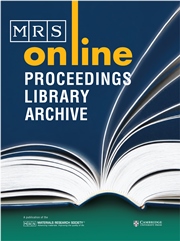Article contents
New Routes to Silicic Acid Containing Inorganic-Organic HybridPrecursors and Polymers
Published online by Cambridge University Press: 21 February 2011
Abstract
In view of the outstanding role that silicic acids (sa.) play in inorganicmaterials a survey will be presented regarding the possibilities of theintegration of sa. in organic matrices via chemical reactions. The objectiveis to combine the advantageous properties of the silicic acid with those ofthe organic compounds in order to generate novel materials. The reactions ofsilicic acids with organic molecules, as studied by 29Si NMRspectroscopy, are described using the silicic acid H8Si8O20 with a defined double four-ringstructure as an example. By silylation of the hydrophilic H8Si8O20 its functional organophilicderivatives were synthesized. The s.a. derivatives with epoxy-, alkoxy-,HSi-, ketoester or unsaturated groups are capable of condensation,polymerization, complexation or additive reactions leading to reactiveinorganic-organic precursors or polymers with the defined silicic acid unit.The synthesis and structure of the following s.a. containing precursors andpolymers will be reported, (a) inorganic-organic polymers with a highcontent of silanol groups, (b) microporous polymers free of silanol groupsand (c) metal (Al, Zr) alkoxide complexes attached to defined silicic acidunits. The model reactions of the double four-ring silicic acid derivativescan be transferred to technical silicic acid solutions preparedfrom water glass. The presented reaction pathways are a basisfor the preparation of a great variety of new inorganic-organic compoundswith tailor-made structures and properties which can be used for highlyhomogeneous and stoichiometric materials.
Information
- Type
- Research Article
- Information
- Copyright
- Copyright © Materials Research Society 1998
References
REFERENCES
- 7
- Cited by

